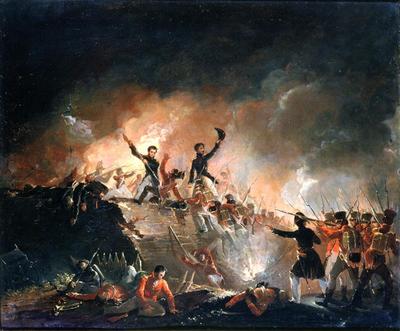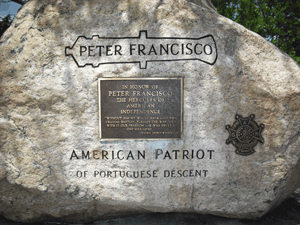Eleazer Wood: Hero of the War of 1812
Eleazer Derby Wood was admitted to West Point on 17 May 1805 from Lunenburg, Massachusetts, graduated 30 October 1806 and was commissioned a Second Lieutenant in the Corps of Engineers on that same day. He was the seventeenth graduate of the United States Military Academy and was almost 23 years old.From 1802 to 1812, the number of cadets at the military academy at West Point was small. The military academy had been established by an act of Congress, on March 16th, 1802. and the total number of graduates by 1812 was only seventy-one. In the beginning ten cadets were attached to the corps of engineers stationed there. This was the first introduction of "cadet" as a grade of officers in the army of the United States. The term cadet, derived from the French, signifying a younger son, was previously applied in England to those young gentlemen who were trained for public employment. The course of instruction was a little over a year long.
After graduation he served as an Assistant Engineer in the construction of the defenses at Governor's Island in New York harbor. The following year, in 1808, he was promoted to First Lieutenant. He then spent several years in Virginia, as his engineering skill, military experience and rank increased. By the beginning of the War of 1812, Wood was a Captain.
Certificate of Promotion – A "Brevet" majority for "Major" Wood [2]Captain Wood was then assigned to the staff of Maj. General William Henry Harrison's Northwestern Army. Harrison placed Wood in charge of the construction of two critical forts on the Lake Erie frontier opposite Canada. In November, 1812, he found himself doing the work of the chief engineer due to the illness of Captain Charles Gratiot, who officially held that post. His service in this capacity included overseeing the construction of Fort Meigs, some work on Fort Stephenson (at present day Fremont, Ohio), and assisting in the movement of Harrison's army into Canada. On May 6, 1813, during the first siege of Fort Meigs, for his exceptional service, General Harrison accorded Wood his first "palm of merit" [1] and had him brevetted major. Each fortification withstood British-Indian sieges and helped establish the reputation for excellence of West Point trained military engineers.
While serving as Harrison's chief engineer and chief artillerist, Wood became his operations officer during the invasion of Canada. After the Battle of the Thames, Major Wood transferred to the Niagara Frontier, where he became the assistant engineer in Maj. General Jacob Brown's army. Wood continued in "operations" as well as his engineering duties. He designed an expansion of Fort Erie similar to that he had used at Fort Meigs. At the Battles of Chippewa (5 July 1814) and Lundy's Lane (25 July), he commanded an artillery section. Following the latter engagement, General Brown paid Wood lavish compliments and had him brevetted again as a lieutenant colonel [3].
Brevet Commission for Lieutenant Colonel Wood after Lundy's Lane,
25 July 1814
After Lundy's Lane, the Americans withdrew from Fort Erie, and Wood received command of a defensive sector. When the British assaulted the U.S. position at Fort Erie (15 August), Wood's battalion-sized command received the brunt of one British brigade's attack and brilliantly repulsed it. The next day, Wood wrote a description of the battle and a letter of recommendation for his officers to his commander. An extract of this letter follows:
Erie /Augt. 16th 1814 Sir In obedience to your instructions I have the honor to report the gallant conduct of my command during the attack which took place on the night of the fourteenth & next. I cannot do greater justice to the troops which I had the honor to command on that occasion then to state that the Twenty First Infantry together with a small detachment of the Seventeenth under Captain Chunno in all about three hundred men aided by the artillery, the skill and activity of that distinguished officer, Capt Lawson of the Artillery, who commands the battery on Snake hill, met and repulsed five impetuous charges given by Colonel Fisher at the head of fourteen hundred British regulars these troops were formed in column of attack and stormed without flints in their muskets. Our lines were completely manned and every wing ready to receive the Enemy when he approached. And perhaps a more signal example of firmness and deadly valour was seldom if ever given by the veterans of Europe. Finding himself repulsed at all points with great slaughter Colonel Fisher saw fit to retire with his shattered columns at dawn of day - Tho the happy result which crowned our arms at this particular point I am under great obligations to Captains Marston and Ropes(?) the former of whom commanded on the left and the latter commanded the Corps of Reserve which repulsed the Enemy at the edge of the water after he had turned the left of the abbatee and completely gained my rear – Capt Chunns who commanded on my right had not the good fortune to come in contact with the enemy until he was sent to reinforce the garrison at Fort Erie where he had a fair opportunity and behaved with great skill and bravery in expelling the enemy from that place, the small reinforcements of riflemen which arrived before the enemy made his final charge under that brave officer Capt Birdsall rendered me considerable service. Lieuts Bowman, Riddle, Hall, Laerned and Ensign Kean, Nealy, Green, Jones, Cummings and Thomas were all extremely active and performed their duty with alacrity. I have to regret that the Army is deprived of the service of Lieut Bushnall and Ensign Liceny Both of whom are severely if not mortally wounded. Our trophy in the morning were about one hundred and twenty Prisoners and a considerable number of scaling ladders, picks, axes, etc.[4]

Two officers said to be Wood and Col. James Gibson are shown in a painting done in 1840 by E. C. Watmough "Repulsion of the British at Fort Erie, 15th August 1814". At this battle Colonel Wood and Gibson were distinguished.
At left, two officers said to be Wood and Col. James Gibson – class of 1808 - are pictured in a painting done in 1840 by E. C. Watmough "Repulsion of the British at Fort Erie, 15th August 1814". At this battle Colonel Wood and Gibson were distinguished.
However, a recent description of the painting describes Lieutenant John Watmough, later brevetted for his "gallant and meritorious" conduct at Fort Erie as being one of the two pictured. [5] (I have contacted the Chicago Historical Society for more details on the painting )
Lieutenant Colonel Wood was being considered for a third brevet promotion for his valor in this action when the following month, he led one of the columns attacking the British works outside Fort Erie on 17 September. This sortie was successful, but during a British counterattack, Wood and Gibson were mortally wounded. Later, the "fort" on Ellis Island was named for Col. Gibson.
Considered by many of his contemporaries as the ideal professional soldier and cited often for his bravery, Wood was honored by General Brown with a monument placed on the parade ground at West Point.
Other honors followed upon his death. At Fort Meigs, Ohio – a fort Col. Wood designed – is a gun battery known as "Wood Battery" and Ohio has named the county containing Fort Meigs also in his honor.
Then there was the naming of a fort on Bedloe's Island in New York harbor.
The army named this 2-1/2 acre fortification on Bedloe's Island – now Liberty Island - "Fort Wood". Today the fort surrounds the base for the Statue of Liberty. A statement from the Acting Secretary of War dated January 23, 1817 showing the "actual number of the Army of the United States and the Station of each corps," [6] contained the following chart. While Fort Wood was "just a small fort in the harbor," today, as the base for the Statue of Liberty, millions of people have become aware of Col. Wood and his supreme sacrifice for his country.
* Also spelled as Eleazor Darby Wood
Bibliography
[1] History of the War with Great Britain in 1812, John Lewis Thomson, J. B. LIPPINCOTT COMPANY, 1887, p. 145.
[2] From the Gilder Lehman Institute collection, PC-01043.07
[3] Ibid., PC-01043.05
[4] Ibid., PC-01043.04
[5] The Final Invasion by Jon Latimer, Osprey Books, 2009, pg. 65.
[6] From the Author's Collection

